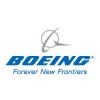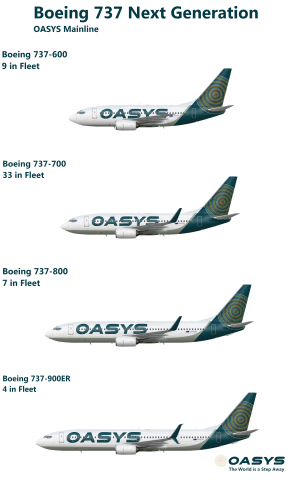
OASYS Boeing 737 Next Generation Family
- Owner: zortan (View all images and albums)
- Uploaded: Apr 05 2020 06:30 PM
- Views: 1,688
- Album OASYS

The 737 Next Generation provided a replacement for the 737 Classic family, which was a common sight in the OASYS fleet until it was retired in 2007. Additionally, the 737 Next Generation replaced the last of the Douglas DC-9 aircraft in the OASYS fleet, bringing in a new era of a unified and modern short- to medium-haul fleet. As one of the first customers of the 737 NG, OASYS took delivery of the first example in 2002, a 737-600, which was followed shortly by the larger -700 and -800 variants. The -900ER followed a few years later, at which point the OASYS 737 NG family was complete.
The Boeing 737-600, like the 737-500 it replaced, is an essential element to the OASYS fleet. The smallest variant of the Boeing 737 Next Generation, the 737-600 is also the longest range, allowing the aircraft to help connect destinations both regionally and internationally. The 737-600 is due to be replaced within the next five to six years, and has already begun the retirement process. The aircraft is currently being replaced by the Embraer E195 E2, and aircraft operating high-demand routes will be replaced by the Boeing 737 MAX 7 once delivery of that aircraft begins.
The Boeing 737-700 is the perfect size for many Australian and regional routes, offering an excellent combination of capacity and range. Currently, OASYS uses the aircraft from hubs at Perth, Sydney and Brisbane, where it operates a large portion of regional flights. Additionally, the 737-700 is used heavily on longer routes, such as Cairns to Singapore and Perth to Kuala Lumpur. The 737-700 will be retired within the next five to six years, as it will be replaced with the Boeing 737 MAX 7.
The 737-800 is currently being phased out, but that doesn't stop it from operating key OASYS services, both domestically and regionally. The aircraft has served with OASYS for 18 years, having replaced select 737-300s and 737-400s in 2002. Currently, the 737-800 can still be seen flying from OASYS hubs at Sydney and Brisbane. The aircraft will be fully replaced by the Boeing 737 MAX 8 in the next two years.
The Boeing 737-900ER revolutionized high-demand routes for OASYS by increasing capacity on the most popular routes. While much of the 737-900ER fleet has been replaced, many aircraft can still be seen flying on the most popular routes as they await their replacement, the Boeing 737 MAX 10. The 737-900ER continues to operate from the Sydney and Brisbane hubs.

 Sign In
Sign In Create Account
Create Account











